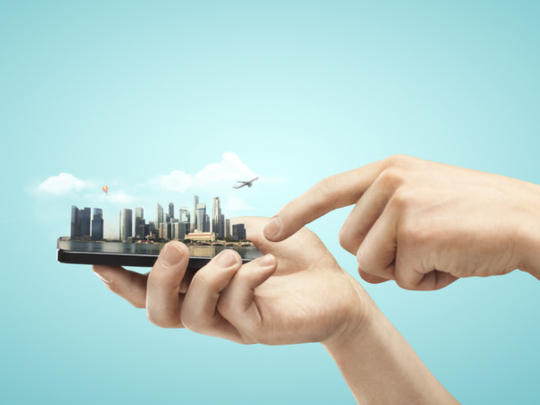
Here’s a new word for you — phubbing. You have been at the receiving end of it. And at the giving end, too. You have seen it at parties, sporting events, dinners, office meetings, during romantic evenings — in fact, it has seeped into every corner of our technologically enhanced lives. Phubbing is the act of snubbing someone in a social setting by looking at your phone instead of paying attention. It is when the smartphone, and what is on it, become more important than the person sitting right in front of you.
Euromonitor International, a market research firm, points to a “dramatically changed” digital landscape, where a “home-centered lifestyle” has given way to individuals “cocooning” themselves in their “own digital worlds, anywhere, any time”. When there is excess cocooning, inevitable side effects include smartphone addiction, “digital distraction”, and a blurring of boundaries between work and leisure.
But as smart devices proliferate rapidly, these digital distractions are going to be the new normal. Gartner estimates IT spending in Europe, the Middle East and Africa will grow annually only at 2.2 per cent through 2017, but the market for smart devices will simply explode, creating a whole new economy — the Internet of Things (IoT) will churn out “tens of millions of new objects and sensors”. The agency notes that in 2009, there were 2.5 billion connected devices. By 2020, that will zip up to a staggering 30 billion, and this will amount to $1.9 trillion (Dh7 trillion) in added economic value. “Digital is not an option, not an add-on, and not an afterthought,” says Dave Aron, Research Vice-President and Gartner Fellow. “It is the new reality that requires comprehensive digital leadership.” To survive this tsunami of smart devices, old-school businesses will have to adapt or perish.
Bigger data
With so many smart devices chatting with each other, exchanging notes, checking what’s new in the cloud, crunching numbers, and sending decisions down the pipe, you can expect massive amounts of data to be sloshing around. Research firm IDC estimates there will be 35 trillion gigabytes of data by 2020, requiring 44 times more data storage than in 2009.
Patrick Hyek, Global Technology Sector Leader at Ernst and Young, believes that in a “smart world” all industries will resemble the technology industry. There will be huge opportunities all around, but also the big sword of disruption hanging overhead. “Ten to 20 years from now, we may look back on the present as the dawn of the smart era: a time when rapid and continuous innovation changed almost everything about the way we live,” he says. Hyek believes much of this change will originate from digital tools that connect to the internet. “These devices will give individuals constant access to information, regardless of location, anytime. They will help trigger an information explosion that blurs the traditional boundaries within, and across, industries,” he adds.
Man meets machine
This future has been dubbed Web 3.0, where there will be a tight integration among intelligent devices, the web and human beings — as opposed to the man versus machine slugfest that Hollywood loves so much.
With easy access to crowdfunding, anyone with a bright idea for a smart device can turn it into an affordable reality. Gartner predicts annual incremental revenue of IoT suppliers will reach $309 billion by 2020. “Half of this will be start-ups and 80 per cent will be in services, not products”.
One of the hottest areas where smart devices are making inroads is what we have dubbed the ‘But It’s For Your Own Good’ (BIFYOG) category.
Sit up
In most cases, these lifestyle devices watch over you and, if you do or don’t do what you should or shouldn’t have done, they spring into action — either by buzzing, beeping, or flashing lights, or more likely by sending alerts to your smartphone, which appear as notifications.
A great example of BIFYOG is LUMOback, a sensor you strap around the waist. Every time you slouch, the device vibrates gently to remind you to sit up straight.
It comes with an iPhone app that graphically lays out how much time you spent sitting, slouching, walking, and even sleeping.
And if you persist with this smart device — as opposed to smashing it against a wall — it will over time “change the way you sit, stand, and move, helping you achieve better health and greater confidence”.
Keep hydrated
Are you drinking enough water? We don’t know, but your smart water bottle does. Successfully funded on Kickstarter, the ILUMI Smartbottle is the “new way to keep hydrated”. It aims at a common problem with modern office life — while working in an AC environment, you forget to drink enough water through the day. But worry not, this smart bottle tracks your intake and communicates with your phone via Bluetooth. If the phone buzzes, it may not be the boss calling, but your bottle.
Eat slower
Now that you are sitting and drinking properly, the next problem to fix is, naturally, food intake. The HAPIfork monitors the rate at which you eat, and if you are gobbling too fast, it alerts you with blinking lights and gentle buzzing, telling you to slow down on the “fork servings taken per minute”. A smartphone app tracks eating habits and generates charts.
An active lifestyle
This is the battleground royale for smart devices. Some of the biggest brands are out there with sensors that you strap or clip on, and then sweat your way to a fitter life. The most famous among the lot are Nike+ Fuelband, along with a bunch of devices from Fitbit such as the One, Flex and Zip, or the Up wristband from Jawbone. You could also try Adidas’ miCoach Smart Run watch, or Motorola’s offering, the Motoactv. Features vary but the underlying goal of these devices is similar — to track your fitness activity and upload the data to an online tool or smartphone app, where you can cull valuable insights to help fine-tune your fitness regimen.
Home sweet home
Home is where smart devices want to be. A well-publicised example is the Nest thermostat. Created by iPod designer Tony Fadell, this smart thermostat learns your patterns and optimises temperature control to reduce energy bills. It can be remotely controlled and scheduled from your phone. Nest has also designed a “smart smoke detector with a human voice”.
Lighter side of things
Forget fiddling with light switches and knobs — you can control home lights the smart way. Not just the intensity, but also the colour, using an app and Wi-Fi. Philips offers the Hue series, where you can create macros and get the bulbs to respond to events — for example, go dim when you go to bed. Meanwhile, the Lifx bulb lets you choose from “millions” of colours, via a phone app. Greenwave Reality Lighting allows illumination control and scheduling for up to 500 Wi-Fi-enabled bulbs.
Lock it up
Smart devices are literally knocking a hole in your door. Using Bluetooth and Wi-Fi, smart locks such as Lockitron and August are operated via smartphone apps. You can set up rules — such as to automatically unlock when you are back, or refuse to open if someone with whom you have just had a fight turns up on your doorstep. You also can grant access to friends and family, and remotely unlock the door if any unexpected visitors arrive.
Finally, if you love pottering around, you could get the Koubachi Wi-Fi Plant Sensor, which measures soil moistness, temperature and light conditions. It “determines the vitality of your plant and sends you a notification with precise care advice at the right time”. You also get access to a plant encyclopedia.
Sense and relay
You can use sensor devices such as Twine and Ninja Blocks to monitor various household activities – such as sending out an alert if you forget to lock the door on your way out. Belkin’s WeMo can automate regular tasks — for example, turning on the coffee machine when you wake up.
But what if...
Make the internet work for you using IFTTT — If This Then That, creating “recipes” along the lines of, “If X happens, then do Y”. For instance, if the baby wakes up, turn on the music. As you can set up a mind-boggling array of such rules, IFTTT is predicted to become a critical and hugely popular player in the smart devices revolution. It will be a junction box connecting various sensors. You can get a taste of it on Ifttt.com — no programming skills required.










